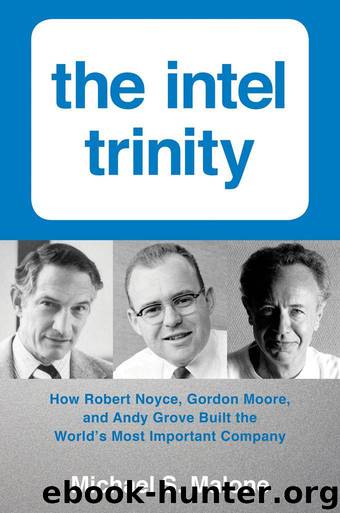Intel Trinity,The: How Robert Noyce, Gordon Moore, and Andy Grove Built the World's Most Important Company by Michael S. Malone

Author:Michael S. Malone
Language: eng
Format: mobi, azw3
Publisher: HarperCollins
Published: 2014-07-14T16:00:00+00:00
CHAPTER 27
Beatification
Intel entered the 1970s as a young start-up dedicated to taking leadership of the MOS memory business. Total annual revenues in 1970 were $4.2 million, losses were $970,000 million, and the company had 200 employees, nearly all of them at Intel’s rented offices in Mountain View.1 By the end of the decade, Intel was still a major player in MOS memory, but prices of those devices were plummeting, largely due to a burst of new domestic competitors and a growing threat from abroad. However, the company was now the leading innovator and manufacturer in the hottest new industry in electronics, microprocessors. Though Motorola was coming on fast, in the last days of 1979, the Crush team would find a novel way to defeat that assault.
Not surprisingly, there were a growing number of employees inside and industry watchers outside the company who were beginning to ask why Intel was still in the memory-chip business at all.
Meanwhile, Intel had grown into a global company, with five factories in the United States and Singapore, and eighty-seven sales offices in seventeen countries, and it was now about to open a huge new fabrication factory near Portland, Oregon. The company’s annual revenues in 1979 were $633 million, profits were $78 million, and it had 14,300 employees, a majority of them working at Intel’s big new headquarters campus in Santa Clara. It had, against all odds, carried the torch of Moore’s Law and had been rewarded with a growth over the decade that almost tracked the law’s exponential curve.
During this period, as Don Hoefler’s newsletter had faded, another, more analytical, newsletter had risen to take its place. It was the product of an already fabled figure, Benjamin Rosen, an elegantly spoken New Orleans boy who had most recently risen to the vice presidency of Morgan Stanley. Rosen was so intrigued by the tech revolution that he retired and started his newsletter (and later a hugely influential industry conference), which gave him access to the boardrooms of the Valley.
Rosen’s newsletter, for its brief run, was probably the most insightful publication in Silicon Valley history—not least because he was among the first analysts to fully understand the implications of Moore’s Law, the microprocessor revolution, and Operation Crush. And because of this understanding, he was the first to describe Intel as “the most important company in the world,” a tagline that, because it proved increasingly accurate, stuck ever after. By 1980, Rosen was gone, to create the venture capital firm Sevin Rosen Funds, which would help found Compaq, Cypress Semiconductor, Lotus, Electronic Arts, and Silicon Graphics—some of them customers and others competitors of the company he had placed at the apex of world commerce.2
Meanwhile, Intel only seemed stronger than ever. It had begun the decade still in the shadow of Fairchild and largely acting in reaction to that other company. Art Rock had been chairman of the board; Bob Noyce, chief executive officer; Gordon Moore, in charge of research; and Andy Grove, a senior manager. Now Rock was gone, back to his venture-capital career.
Download
Intel Trinity,The: How Robert Noyce, Gordon Moore, and Andy Grove Built the World's Most Important Company by Michael S. Malone.azw3
This site does not store any files on its server. We only index and link to content provided by other sites. Please contact the content providers to delete copyright contents if any and email us, we'll remove relevant links or contents immediately.
Life 3.0: Being Human in the Age of Artificial Intelligence by Tegmark Max(5402)
The Sports Rules Book by Human Kinetics(4210)
The Age of Surveillance Capitalism by Shoshana Zuboff(4115)
ACT Math For Dummies by Zegarelli Mark(3931)
Unlabel: Selling You Without Selling Out by Marc Ecko(3552)
Blood, Sweat, and Pixels by Jason Schreier(3530)
Hidden Persuasion: 33 psychological influence techniques in advertising by Marc Andrews & Matthijs van Leeuwen & Rick van Baaren(3413)
The Pixar Touch by David A. Price(3329)
Urban Outlaw by Magnus Walker(3300)
Bad Pharma by Ben Goldacre(3205)
Project Animal Farm: An Accidental Journey into the Secret World of Farming and the Truth About Our Food by Sonia Faruqi(3138)
Kitchen confidential by Anthony Bourdain(2966)
Brotopia by Emily Chang(2947)
Slugfest by Reed Tucker(2896)
The Content Trap by Bharat Anand(2835)
The Airbnb Story by Leigh Gallagher(2749)
Coffee for One by KJ Fallon(2515)
Smuggler's Cove: Exotic Cocktails, Rum, and the Cult of Tiki by Martin Cate & Rebecca Cate(2423)
Beer is proof God loves us by Charles W. Bamforth(2339)
